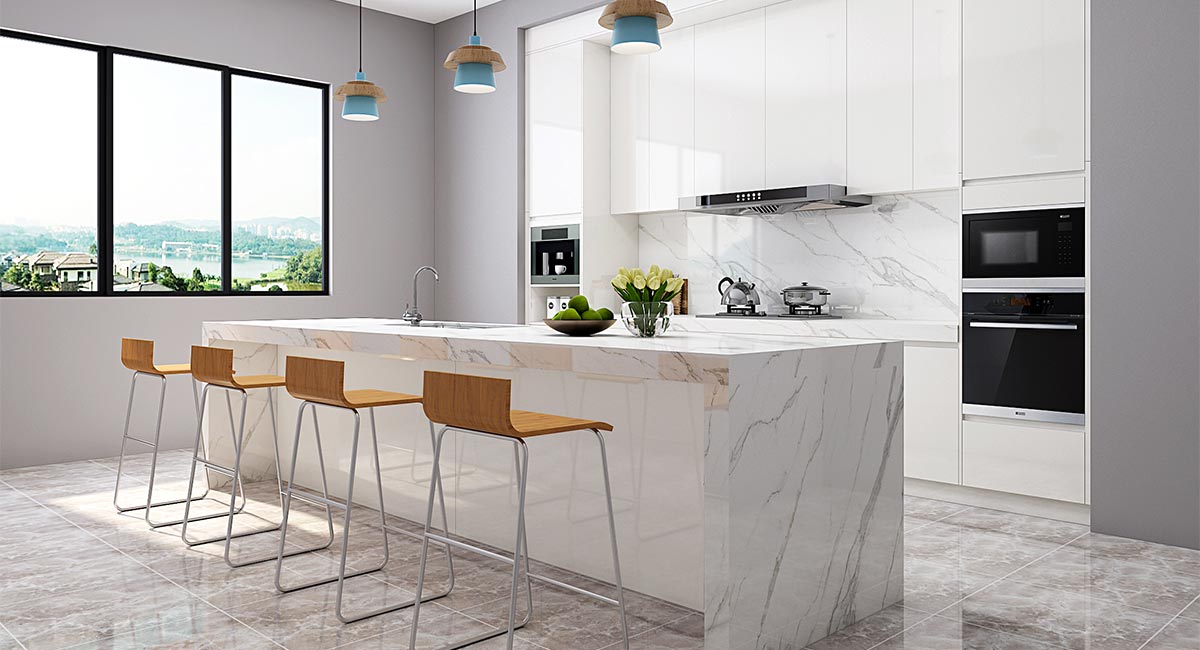If you’d asked most homeowners twenty years ago about their dream kitchen, chances are the words “stone island” or “granite counter” would have popped up. Back then, a quartz worktop or a granite worktop was the sort of thing you saw in design magazines or celebrity homes — glamorous, shiny, and completely out of reach for the average household budget.
Fast forward to today, and quartz is suddenly everywhere. You see it in rental flats, in suburban new-builds, in the neighbour’s kitchen down the road. What happened? Did everyone win the lottery at the same time? Not quite. The real reason quartz has gone from luxury to “pretty normal” is technology. Machines got smarter, supply chains got slicker, and the whole industry figured out how to make premium surfaces without premium-only price tags.
And honestly, that shift tells you as much about global tech trends as it does about kitchens.
When Quartz Was the Rolls Royce of Worktops
Let’s roll back a bit. Quartz surfaces first arrived in the 1960s in Italy, and they were genuinely space-age for their time. A mix of crushed stone and resin pressed into solid slabs that were stronger than granite and way easier to live with. No sealing, less staining, fewer headaches. The catch? It cost a fortune.
Part of that was the machinery — huge, expensive, specialised. Part of it was style choice (early quartz came in a handful of plain shades, so you paid big for something that, frankly, wasn’t always that exciting to look at). And part of it was just plain exclusivity. Like anything new, it sat firmly at the luxury end of the market.
If you had quartz in your kitchen in the 80s or 90s, you were making a statement. And the statement was: “I’ve got cash to spare.”
How Globalization Brought Prices Down
Then along came the 90s and 2000s, and with them, globalization. Manufacturers started popping up outside Europe. Asia got in on the game, America scaled things up, and before long you had a proper global marketplace for quartz slabs.
Competition is always healthy. Suddenly, it wasn’t just a few Italian factories setting the prices. Mass production meant slabs could be made faster, cheaper, and shipped further. Think IKEA effect: once you figure out how to do something at scale, costs drop for everyone.
That’s when quartz stopped being just for luxury kitchens and started creeping into more “normal” reno budgets.
CNC Machines and Laser Precision
Here’s where it gets geeky (and kind of cool). The real turning point was in fabrication. Back in the day, fabricating a worktop was almost an art form. Skilled stonemasons cutting by hand, carefully shaping edges, crossing fingers that they didn’t crack a slab mid-way. Skilled work, but slow and pricey.
Enter CNC (computer numerical control) machines. These bad boys cut quartz like butter, with waterjets and laser-guided routers doing the work humans used to spend hours on. The benefits?
Less waste — digital layouts mean slabs are cut with maximum efficiency.
Lower labor costs — machines handle the grunt work, so prices don’t need to cover weeks of manual labor.
More creativity — fancy edge details, sleek sink cut-outs, or a waterfall island are suddenly affordable options.
Basically, tech took the “artisanal” part of fabrication and supercharged it. That’s why you can now order a custom-cut quartz island without needing a celebrity bank balance.
The Style Upgrade Nobody Saw Coming
If early quartz was a bit… bland (let’s be honest, those solid beige slabs didn’t exactly scream excitement), the chemistry world came to the rescue. Advances in resins and pigments completely changed the game.
Suddenly, you could get quartz that looked like marble, or a granite twin, or even wild patterns and colours you’d never find in nature. That meant homeowners didn’t just choose quartz for practical reasons — they wanted it because it looked incredible.
And here’s the kicker: making those patterns with quartz is actually easier and more reliable than quarrying real stone. No trekking into the mountains hoping for a perfect slab. No nasty surprises when two slabs don’t match. Just consistent, beautiful design at scale. That’s another reason prices came down. Less unpredictability = less wasted money.
Tech Took the Guesswork Out of Buying
Anyone who’s remodeled a kitchen knows that making decisions can be torture. Will that dark surface make the room feel smaller? Will the veining clash with the cabinets? Will I regret it the second it’s installed?
A decade ago, the only way to find out was to squint at a 5cm sample in a showroom and pray. Today? You pull up an AR app or a kitchen visualiser, drop a quartz surface into a 3D model of your kitchen, and boom — decision made.
This digital leap doesn’t just make customers happier. It speeds up sales, reduces hesitation, and keeps costs lower for suppliers. Less back-and-forth, fewer wasted orders. Which, again, filters down into affordability.
Smarter Supply Chains = Cheaper Slabs
Behind the scenes, logistics has also had a glow-up. Real-time tracking, AI predicting demand, warehouses synced with suppliers across continents. Sounds boring, but it means one simple thing: slabs get where they need to go faster and with fewer hiccups.
In the past, if a shipment was delayed or stock was low, prices shot up. Now, with tech smoothing out the supply chain, suppliers can keep things steady — and consumers don’t get hammered with surprise price hikes.
Quartz vs Granite: The Rivalry
Of course, we can’t talk quartz without mentioning granite. Granite ruled the worktop world for decades. Authentic, natural, undeniably beautiful. But it has quirks — natural variation, sealing requirements, occasional staining dramas.
When quartz started looking like granite but behaving better (uniform, low-maintenance, easier to source), lots of homeowners jumped ship. Not that granite is going anywhere — plenty of people still want the romance of a natural slab. But technology basically gave quartz a way to compete on looks and win on practicality. That’s why quartz now feels mainstream.
Eco Tech Made It Even Stronger
Another part of the story is sustainability. Modern quartz makers are using recycled stone, greener resins, and energy-efficient plants. Not only does this cut environmental impact (a big deal for today’s eco-conscious buyers), but it also trims waste and costs.
Green tech isn’t always cheap in other industries, but in quartz, it’s been a win-win: better for the planet, and better for affordability.
Why Quartz Feels Like “Democratised Luxury”
Here’s the real takeaway. Quartz went the way of smartphones, flat-screen TVs, or once-rare designer handbags: tech made them scalable, affordable, and suddenly “normal”. What used to scream “luxury” now quietly sits in millions of homes.
And honestly, that’s no bad thing. Renovating a kitchen is stressful and expensive enough. Having premium-looking, durable options at mainstream prices? That’s the sort of tech revolution most homeowners can get behind.
Looking Ahead
So, what’s next? Expect even more innovation. Think:
Quartz surfaces with built-in antimicrobial tech.
Nanocoatings that make them virtually scratch-proof.
Even smarter AR tools so you can design your whole kitchen on a phone in your lunch break.
And as the tech improves, prices won’t shoot back up — they’ll probably keep levelling out. Meaning more households will keep upgrading from laminate to quartz without blinking.
Final Word
Quartz’s journey from “dream kitchen” to “new normal” is basically the story of how technology shifts entire industries. From CNC machines to pigments, from AR apps to smart supply chains, each step has shaved down costs and opened up access.
Today, whether you want the natural charm of a granite worktop or the dependable versatility of a quartz worktop, you’re not locked out by price anymore. And that — unlike a trendy fridge that pings your phone — is tech progress that actually makes everyday life better.































